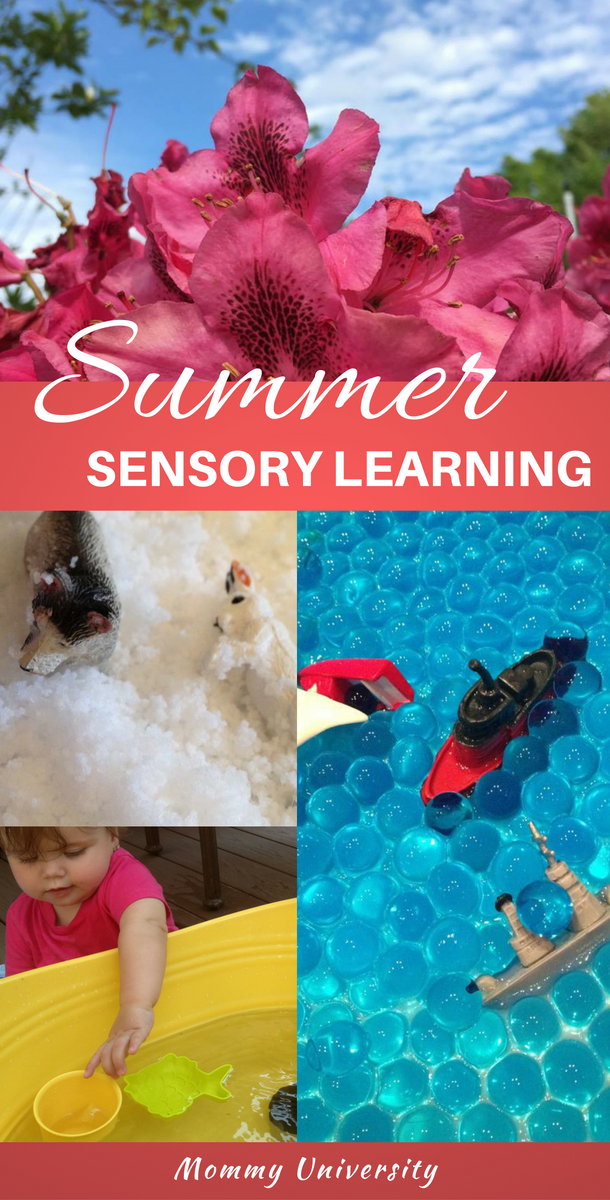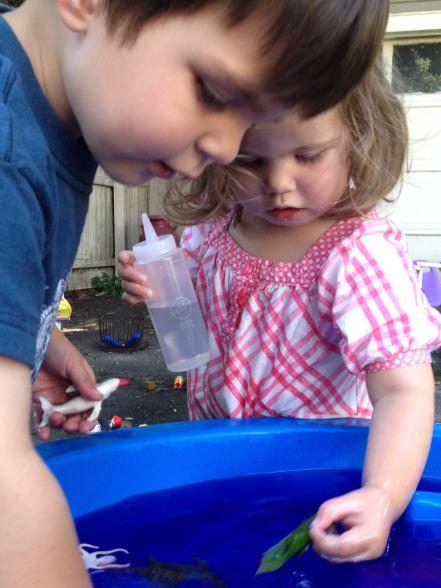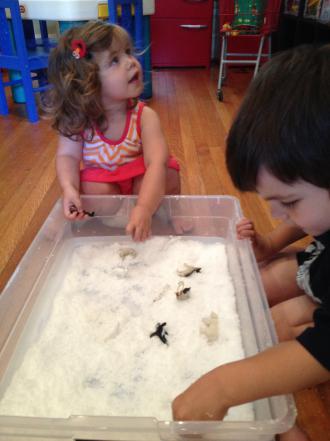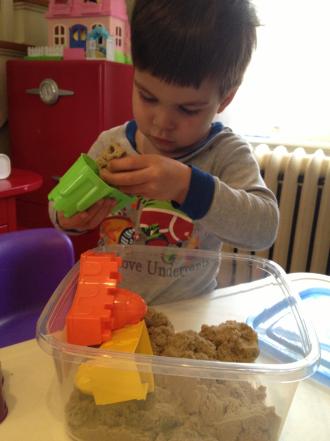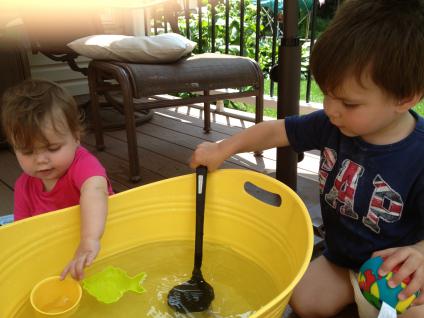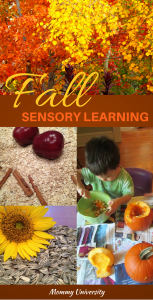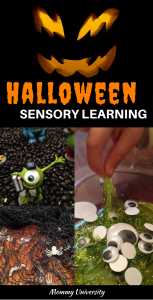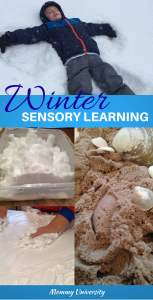Did you know that babies absorb information by utilizing all their senses?
It is not uncommon to see a baby chew on an object to better understand that item. As they mature, they further explore utilizing other senses. This information provides them with feedback that helps them to better understand the world that surrounds them.
Sensory play is very important for babies and children which is why fabric as well as touch and feel books are so popular at baby showers. Sensory play is very important for a child’s development which is why sensory bins have become very popular on blogs and Pinterest.
Sensory Bins first captivated my attention when a virtual friend kept posting photos of her daughter playing with dyed rice. At first, I couldn’t understand the time and effort that was spent on rainbow colored rice. However, after my son began Early Intervention and receiving Occupational Therapy, this story quickly changed.
A sensory bin has several parts: container, filler and manipulatives. The most commonly seen container is a clear bin around 23” in length that can be purchased at Target. The filler is the material that fills the container which will provide your child with plenty of feedback: smell, texture and weight. The manipulatives can be cups, plastic toys or items that fulfill a theme (if you want to do a theme). However, remember you can control how much time and money you want to invest in the creation of the sensory bin. Lastly, if you keep the sensory bin inside your home you might want to put a mat underneath for filler that escapes the container. A table cloth or cheap shower curtain from the dollar store can be the mat.
This summer I created several opportunities for sensory play for my children. Here are some sensory bins I created:
Ice, Ice Baby
Courtesy of Pinterest, I froze one large chunk of ice for my children to play with during the heat of a July afternoon. To make this interesting, I added food coloring and included a Toob of Marine Life. Every couple of hours I added more water, some food coloring, and threw in small figurines of aquatic life. The large chunk of ocean ice was put in our water table where both of my children were able to explore through touch. We also talked about the different animals and expanded our vocabulary.
Frozen Sensory Bin
My children, like most children, are obsessed with Frozen. Who can resist singing “Do you want to build a snowman?” (Don’t worry I am sure there are some that have the ability to ignore the catchy tune). With a few scoops of Insta-Snow (which I purchased on Amazon) and a Toob of Arctic Animals, we had a Frozen afternoon. The kids loved watching the material expand as we added water, and dipping their hands in the cool material made them giggle. My son focused on the caribou that he called Sven. It definitely encouraged his vocabulary as he talked about everything Sven and his friends were doing. We played with the snow and shaped it into different geometric shapes. If you have Frozen figurines you can use those instead.
Boats Sensory Bin
As a participant in the Virtual Book Club, we spent one week reading about Things that Go. My son loves Byron Barton’s book called Boats. It is a calming read that we do right before he and his sister are allowed to play with this bin. Our storage container was pulled out and the filler for this sensory bin was blue water beads. Water beads do take a long time to absorb water but last a few days. In the morning, we measured the beads out and poured water in the container. Each hour we checked on the beads and talked about how they grew. Once they were a good size, I let my children play in the “water”. Once again, I went to my collection of Toobs and poured boats into the water and they had fun identifying the various boats.
Sand Castle Sensory Bin
A plastic container, some plastic castle molds from the dollar store, and Kinetic Sand are the ingredients for this Sensory Bin. Kinetic Sand can be pricey but it is becoming more accessible and can be found in Michaels, AC Moore, and Amazon. Kinetic Sand is different from Moon Sand, Sands Alive, or Cloud Dough. Honestly, while my children make different shapes out of Kinetic Sand, I also play with it. It just feels good and relaxes me.
Birds Sensory Bin
The Birds Sensory Bin was inspired after my son made a bird feeder at the Home Depot Kids Workshop. Since we haven’t placed it in our backyard, I thought let’s create a bird theme sensory bin and then hang the bird feeder in the backyard. This sensory bin is filled with bird seed, Toob of Backyard Birds, and pine cones which we collected when we were on vacation in Georgia a few months ago. Since this will be a messy project, I am going to have the kids outside to explore this bin. The kids loved playing with this bin, filling containers, but my largest surprise was when my son grabbed his bird feeder and inserted into the bin. He told me he was going to feed the birds and he gently picked each one up and played with them.
Water Table/Bin/Tub
A simple water table will keep your children occupied during the scorching summer days which is sensory play. Last summer, I put a large bright colored plastic container on the back porch and filled it with water. After throwing in some cups, measuring spoons, my two year old and one year old kept themselves busy for a very long time. Similarly, I have thrown a plastic tub on our kitchen floor and filled with water, soap, and plastic containers to play. For outdoor water tables, it is important to empty out after playing so that it doesn’t become a breeding area for mosquitoes.
Sensory Bins are great for providing tactile feedback to children. They can explore different textures and weights. It is important to note that while some fillers can be edible it is important to be conscientious about your bins. If your children are very young, they will want to put things in their mouth or you may have a child that still likes to taste things (remember, for infants, the mouth is how they first learn about the world) so don’t leave them unattended if you are concerned about them eating items they should not.
Sensory bins can be messy which is tied to the children’s age, the filler material and obviously the location. In other words, don’t try a sensory bin on a brand new carpet. If you are worried about the mess, you can put a blanket underneath or if the weather is nice take it outside.
